



Introduced: 2006 (Model Power version) and 2017 (revised MRC version)
This was the last in a line of Korean-made steam locomotives from Model Power. Said line included (along with this Mogul) a 4-6-2 Pacific, a 2-8-2 Mikado and a 4-4-0 American (the 2-6-0 and 4-4-0 share the exact same locomotive and tender shells). These Moguls are available in a variety of different configurations (with the detailing varying based on the prototype in question) -
• Headlight (Top or Center)
• Pilot (Foot Board or Boiler Tube)
• Cylinder Type (Slide Cylinder or Valve Cylinder)
• Cab Windows (Rectangular or Arched)
• Tender Trucks (Andrews or Arch Bar)
All of the alternate options are supplied ala carte with the undecorated units, allowing you to configure them however you like -
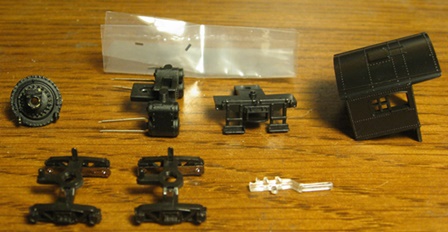
Model Power went out of business in 2014 and was subsequently acquired by MRC. In 2017, MRC released revised versions of these models (still in the old Model Power packaging, but with MRC mentioned on the box). These new models are a considerable upgrade over the original version (and available with DCC-Sound), but before we discuss those let's first take a look at the older ones.
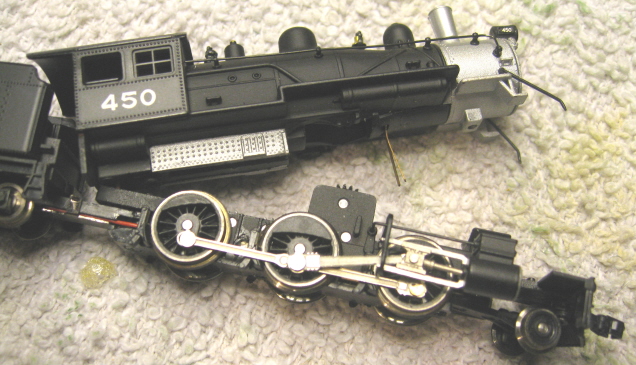
The shell and mechanism are a total Chinese puzzle box of interconnected parts and, as a consequence, pretty difficult to disassemble. To separate the boiler shell from the chassis, you first have to unscrew the screw underneath the pilot truck and then the rearmost screw on the driver bottom plate. The boiler section should separate from the chassis at this point (just give it a bit of a tug to free the central gear tower from the shell). However, since there are wires running from the drawbar into the shell, you won't be able to move the shell very far.
The motor, flywheel, driveshaft, worm gear and headlight all live up inside the boiler. To access the motor (and beyond) you first need to remove the cab (spread the sides apart and it should pop off). Next, you need to remove the boiler backplate "detail" (free the two side clips from the shell). The motor and worm should slide out of the back of the boiler at that point (in theory, anyway - I've never actually tried).
The engine chassis and shell are both metal. The motor is a 5-pole Mashima. And as alluded to above, the driveshaft includes a flywheel. Only the rear two sets of drivers are geared, and with the exception of the brass worm, all gearing is plastic. A non-directional headlight is mounted inside the boiler. Current reaches the headlight by way of long metal contacts that extend all the way down to the driver wipers. Said contacts are extremely difficult to get realigned (IE, back in contact) if you ever have to remove the bottom driver plate. There is no backup light in the tender.
The pilot coupler is an operational (albeit non-automatic) knuckle. The tender coupler is a truck-mounted Rapido (easily replaced by a Micro-Trains coupler assembly). The drawbar is plastic, permanantly held in place on either end, and absolutely full of wires. All wheels are blackened and low-profile (no problems on Code-55 rails). The pilot truck has a bendy metal tang inside of its arm (providing downward pressure on the truck).
Pickup is provided by the forward two pairs of drivers (with the pilot truck being electrically neutral and the rear driverset being equipped with traction tires). Four of the eight tender wheels provide pickup as well. Unfortunately, current is collected from the wheels by way of axle wipers (an archaic and notoriously unreliable scheme).

The kinda/sorta good news is that this model is kinda/sorta DCC-Ready. Model Power has provided color-coded wiring leads in the tender for pickup and motor control (unfortunately, there is no wiring for headlight control). So, no, not a simple plug'n'play decoder install. But still, about as painless as it gets otherwise. The tender shell is held on via simple friction and pulls off with minimal effort -
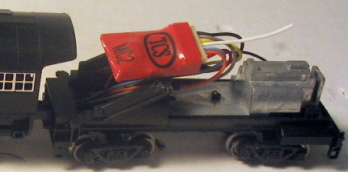
The basic mechanism generally runs smoothly and quietly (no shimmying or wobbling or weird noises or anything like that). Having said that, I have noticed that at least some of these 2-6-0's can initially have a bit of a bind to the mechanism (being fairly herky-jerky at slow speeds). As an experiment, I've tried loosening the screws along the bottom of the driver plate a bit (a turn or so). After making this adjustment, performance smoothed out significantly. Thanks to the traction tires, these 2-6-0's are decent pullers right out of the box.
Like the similarly designed 4-4-0, these 2-6-0's do tend to run a bit better than Model Power's earlier 2-8-2 and 4-6-2 models. Now, I suppose this could simply be due to improved QC at Ajin. However, one very noticeable change between this model and the earlier Pacific and Mikado models is the design of the driver wipers. The wipers on the 2-6-0 (as well as the 4-4-0) point "up and down" (as opposed to the wipers on those earlier models, which point "left and right"). I'm assuming this explains why the wipers on these smaller steamers have less of a tendancy to get all bent and mangled by the drivers - a notorious problem with the earlier design.

Despite the improved driver wipers, you still have those axle wipers on the tender to contend with. And as we all know, flimsy metal wipers (be they on axles or behind drivers) are a pain in the ass - they like to lose contact over time, they love to collect all manner of gunk and crud, and they're very difficult to clean. So really, it's just a matter of time before pickup starts to go south on these things. So, ultimately not a particularly useful locomotive.
As noted above, MRC released improved versions of these models in 2017. And the really good news is that the pickup on the tender trucks was completely redesigned. As you can see, gone are the axle wipers (replaced instead by needlepoint axle / dimpled wiper cup pickup on all eight wheels) -
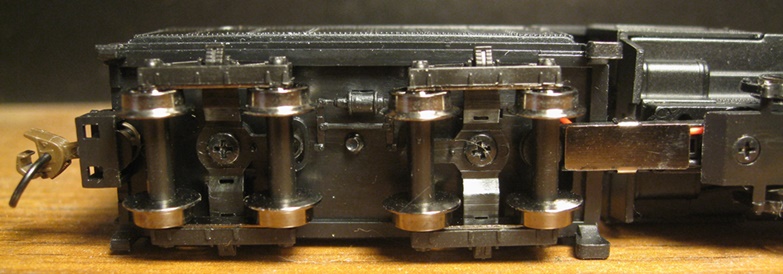
Internally, the gearing was changed over to the same greyish looking plastic used by Ajin on their revised 2-8-2 and 4-6-2 models. Oddly enough, the couplers were changed over to the exact same McHenry-style couplers used by Bachmann on their locomotives of similar vintage (and with the tender coupler now being chassis-mounted rather than truck-mounted).

The driver wipers were changed from being vertically-oriented to horizontally-oriented (not sure if that's good news or bad news). The rear driver pair is now equipped with its own set of wipers, but since the drivers are equipped with traction tires it seems unlikely that they could provide much in the way of current conductivity.

As on the revised Mikado and Pacific models, wiring for DCC headlight control was also added to these models. Unfortunately, only one wire (running back to the tender) was added. As pictured below, right-rail current for the headlight still comes from one of those annoying metal contacts running down to the driver pickup -

Apart from an extra weight glued inside the shell. nothing much changed inside the tender. On the DCC-Sound models, all they did was connect up an MRC sound decoder to the existing wiring (and with the speaker nestled inside of a foam ring glued to the inside of the shell). I'm told that the decoder is an MRC 1961 (specifically designed for use on these MRC steamers). The tender itself was not modified for sound (IE there aren't any speaker holes in the chassis or anything like that). The sound is somewhat underwhelming to my ear, but since I remain unimpressed by N scale sound in general you're going to have to take my opinions in that regard with a grain of salt.
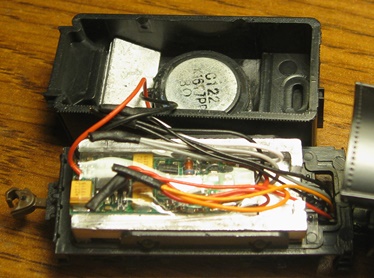
Performance on this revised version is simply outstanding. Mine runs smoothly and quietly at all throttle levels. Slow speed creep is impressive and the top-end speed is very reasonable. I didn't have any pickup-related issues (stalling, stuttering, etc). No wobbling, shimmying, or binding either. Pulling power is strong, with mine comfortably able to handle 25+ assorted freight cars on level track. And although I do still have my reservations about the driver wiper situation, I think the benefits of the new tender pickup scheme should serve to cancel out any potential issues there. Overall, these are gorgeous looking models with performance to match.
In 2019, Heartland Hobby purchased the tooling for the old Model Power line of N scale locomotives from MRC. It's anyone's guess what (if anything) they plan on doing with it, but it's entirely possible that we've seen the last of them.
MRC Features -
• 5-Pole Mashima Motor
• Metal Boiler, Chassis, and Cylinders
• Separatley Applied Metal Handrails
• Golden White LED
• Fly-Wheel Drive
• Traction Tire Factory Installed
• Front/Rear Knuckle Couplers
• Axle Pin Tender Truck Pick-Ups
• LED Wiring To Tender
• Extra Weight in Tender
• Available With Factory Installed DCC & Sound
Grades: C (Model Power version) and A (MRC version)